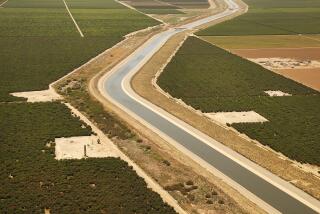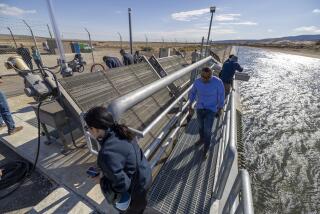Most Central Valley farmers unlikely to get federal water, again

- Share via
In another blow to California’s parched heartland, federal officials said Friday that for the second year in a row most Central Valley farmers are unlikely to receive water from the region’s major irrigation project this summer.
The announcement, while expected, means growers will probably have to idle more land — and produce fewer crops — because there is simply not enough water for all of their fields.
“It’s frustrating that we’ll be fallowing the same or more land than last year,” said Dan Errotabere, a vegetable and nut farmer in Riverdale, 25 miles southwest of Fresno. “That equates to lost revenue, lost taxes and less employee hours. The effect on communities is real.”
Citing below-average reservoir storage and an abysmal snowpack as California enters a fourth year of drought, managers of the federal Central Valley Project said they probably will not deliver any supplies this year to farmers in the system who don’t have senior water rights.
“The picture is not a pretty one,” said David Murillo, regional director of the U.S. Bureau of Reclamation.
The agency’s initial assessment of how much water they can send to growers is always conservative. There are still two months left in the rainy season and if conditions improve, so could the allocation.
Moreover, the zero allocation doesn’t apply to farmers in the Sacramento and San Joaquin valleys who have historic water rights that the government must honor before they dole out supplies to everyone else. The bureau expects to send those farmers 75% of their sizable contract amounts, or a total of about 2.6 million acre-feet.
“We have quite a few buckets to fill before we can start making water available” to growers who lack senior rights, said Ron Milligan, CVP operations chief.
Cities supplied by the project will get at least a quarter of their typical deliveries, and federal wildlife refuges will probably get 75% of normal deliveries.
All told, officials estimated that the project would deliver about half the water it does in a typical year.
But for many Central Valley growers, 2015 is looking worse than last year, when they left between 400,000 and 500,000 acres unplanted for lack of water, dealing a $2-billion blow to the state’s agricultural sector.
“Last year was a struggle, and now we’re dealing with the accumulative effect in year four of drought,” said Ryan Jacobsen, executive director of the Fresno County Farm Bureau. “As we move forward, we’re
predicting this will be the most difficult year facing the San Joaquin Valley in 50 years.”
Farmers have been turning to their wells to carry them through the drought, drilling anew, deepening existing ones and reducing groundwater levels in many parts of the San Joaquin Valley to historic lows.
“Farmers that have two to three wells on the books are asking me to do a couple more,” said Steve Arthur, a well driller based in Fresno. “We’re so busy we had to order another drill rig.”
Some growers are drilling as deep as 1,700 feet as the competition for groundwater increases. “Farmers can’t survive forever without federal water,” Arthur said. “They can’t keep spending all their money on water wells. Something will come to an end sooner or later.”
Thanks to storms in December and early February, the state’s major reservoirs are fuller than they were at this time last year. Shasta Lake, the largest reservoir in California and a key source for the CVP, is 57% full, compared with 39% a year ago.
But the warm storms did little for the mountain snowpack, which has dwindled to 19% of the statewide norm. That means there won’t be much spring snowmelt to replenish reservoirs.
Growers noted that when Shasta was at a similar level in the 1987 to 1992 drought, the CVP sent most farmers 25% of their contract amounts. They blamed the difference on endangered species protections that at times restrict pumping from the Sacramento-San Joaquin River Delta.
“There is no question that new federal rules and regulations restricting the flow of water have contributed greatly to the human suffering that will occur in this third year of nearly zero or grossly inadequate allocations,” Westlands Water District President Don Peracchi said in a statement.
Milligan acknowledged that “there are a few more regulatory requirements today than we had in 1992.” But he said the current drought conditions are in some respects worse than two decades ago.
[email protected]
Twitter: @boxall
[email protected]
Twitter: @dhpierson
More to Read
Sign up for Essential California
The most important California stories and recommendations in your inbox every morning.
You may occasionally receive promotional content from the Los Angeles Times.












